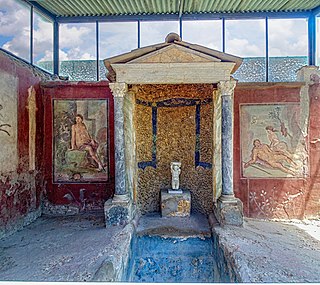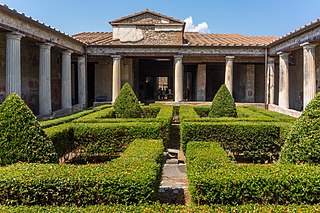
Lucius Caecilius Iucundus was a banker who lived in the Roman town of Pompeii around AD 14–62. His house still stands and can be seen in the ruins of the city of Pompeii which remain after being partially destroyed by the eruption of Vesuvius in AD 79. The house is known both for its frescoes and for the trove of wax tablets discovered there in 1875, which gave scholars access to the records of Iucundus' banking operations.

In ancient Rome, the domus was the type of town house occupied by the upper classes and some wealthy freedmen during the Republican and Imperial eras. It was found in almost all the major cities throughout the Roman territories. The modern English word domestic comes from Latin domesticus, which is derived from the word domus. Along with a domus in the city, many of the richest families of ancient Rome also owned a separate country house known as a villa. Many chose to live primarily, or even exclusively, in their villas; these homes were generally much grander in scale and on larger acres of land due to more space outside the walled and fortified city.
Below are notable events in archaeology that occurred in 1893.

Cavaedium or atrium are Latin names for the principal room of an ancient Roman house, which usually had a central opening in the roof (compluvium) and a rainwater pool (impluvium) beneath it. The cavaedium passively collected, filtered, stored, and cooled rainwater. It also daylit, passively cooled and passively ventilated the house.

The Villa Poppaea is an ancient luxurious Roman seaside villa located in Torre Annunziata between Naples and Sorrento, in Southern Italy. It is also called the Villa Oplontis or Oplontis Villa A. as it was situated in the ancient Roman town of Oplontis.

The Villa of the Mysteries is a well-preserved suburban ancient Roman villa on the outskirts of Pompeii, southern Italy. It is famous for the series of exquisite frescos in Room 5, which are usually interpreted as showing the initiation of a bride into a Greco-Roman mystery cult. These are now among the best known of the relatively rare survivals of Ancient Roman painting from the 1st century BC.

Pompeii and Herculaneum were once thriving towns, 2,000 years ago, in the Bay of Naples. Both cities have rich histories influenced by Greeks, Oscans, Etruscans, Samnites and finally the Romans. They are most renowned for their destruction: both were buried in the AD 79 eruption of Mount Vesuvius. For over 1,500 years, these cities were left in remarkable states of preservation underneath volcanic ash, mud and rubble. The eruption obliterated the towns but in doing so, was the cause of their longevity and survival over the centuries.

The House of the Faun, constructed in the 2nd century BC during the Samnite period, was a grand Hellenistic palace that was framed by peristyle in Pompeii, Italy. The historical significance in this impressive estate is found in the many great pieces of art that were well preserved from the ash of the eruption of Mount Vesuvius in 79 AD. It is one of the most luxurious aristocratic houses from the Roman Republic, and reflects this period better than most archaeological evidence found even in Rome itself.

The House of the Tragic Poet is a Roman house in Pompeii, Italy dating to the 2nd century BC. The house is famous for its elaborate mosaic floors and frescoes depicting scenes from Greek mythology.

The House of Loreius Tiburtinus is renowned for well-preserved art, mainly in wall-paintings as well as its large gardens.

The House of Menander is one of the richest and most magnificent houses in ancient Pompeii in terms of architecture, decoration and contents, and covers a large area of about 1,800 square metres (19,000 sq ft) occupying most of its insula. Its quality means the owner must have been an aristocrat involved in politics, with great taste for art.

Villa Boscoreale is a name given to any of several Roman villas discovered in the district of Boscoreale, Italy. They were all buried and preserved by the eruption of Mount Vesuvius in 79 AD, along with Pompeii and Herculaneum. The only one visible in situ today is the Villa Regina, the others being reburied soon after their discovery. Although these villas can be classified as "rustic" rather than of otium due to their agricultural sections and sometimes lack of the most luxurious amenities, they were often embellished with extremely luxurious decorations such as frescoes, testifying to the wealth of the owners. Among the most important finds are the exquisite frescoes from the Villa of Publius Fannius Synistor and the sumptuous Boscoreale Treasure of the Villa della Pisanella, which is now displayed in several major museums.

The House of the Surgeon is one of the most famous houses in the ancient Roman city of Pompeii and is named after ancient surgical instruments that were found there. Along with the rest of the city, it was buried and largely preserved under 4 to 6 m of volcanic ash and pumice in the Eruption of Mount Vesuvius in 79 AD.It was excavated in 1770 by Francesco La Vega.

Oplontis is an ancient Roman archaeological site, located in the town of Torre Annunziata, south of Naples in the Campania region of southern Italy. The excavated site comprises two Roman villas, the best-known of which is Villa A, the so-called Villa Poppaea.

Stabiae was an ancient city situated near the modern town of Castellammare di Stabia and approximately 4.5 km southwest of Pompeii. Like Pompeii, and being only 16 km (9.9 mi) from Mount Vesuvius, it was largely buried by tephra ash in 79 AD eruption of Mount Vesuvius, in this case at a shallower depth of up to 5 m.

Herculaneum was an ancient Roman town, located in the modern-day comune of Ercolano, Campania, Italy. Herculaneum was buried under volcanic ash and pumice in the Eruption of Mount Vesuvius in 79 AD.

The House of Sallust was an elite residence (domus) in the ancient Roman city of Pompeii and among the most sumptuous of the city.

The House of the Centenary was the house of a wealthy resident of Pompeii, preserved by the eruption of Mount Vesuvius in 79 AD. The house was discovered in 1879, and was given its modern name to mark the 18th centenary of the disaster. Built in the mid-2nd century BC, it is among the largest houses in the city, with private baths, a nymphaeum, a fish pond (piscina), and two atria. The Centenary underwent a remodeling around 15 AD, at which time the bath complex and swimming pool were added. In the last years before the eruption, several rooms had been extensively redecorated with a number of paintings.

The House of the Prince of Naples is a Roman domus (townhouse) located in the ancient Roman city of Pompeii near Naples, Italy. The structure is so named because the Prince and Princess of Naples attended a ceremonial excavation of selected rooms there in 1898.

The House of the Greek Epigrams is a Roman residence in the ancient town of Pompeii that was destroyed by the eruption of Mount Vesuvius in 79 CE. It is named after wall paintings with inscriptions from Greek epigrams in a small room (y) next to the peristyle.




















